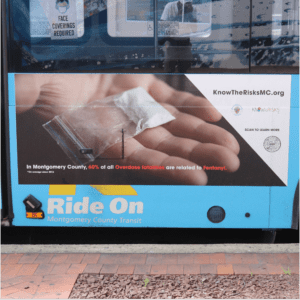17 year-old Inika Singh explores the lucrative but deadly business of the infamous Sinaloa Cartel

Montgomery County Transit RIDE ON Bus along Colesville Road between Wayne Avenue and Georgia Avenue in Silver Spring, Maryland.
September 12, 2024
The fentanyl crisis is 'destroying lives'
In the Mexican border town of Tijuana, a man named Mario has injected heroin laced with fentanyl – which is 50 times more powerful than heroin – and overdosed, as explained in an investigation by Channel 4 News.
A volunteer nurse gives him CPR and Naloxone, an emergency medicine that reverses opioid overdose. This medicine is not produced in Mexico and needs to be smuggled in from the United States.
Mario survives, but an overdose death can happen in the blink of an eye, so the volunteer will try to persuade addicts like him to seek help from a rehabilitation centre. This treatment centre is unique – it is run by none other than the drug cartel that supplied the drugs in the first place.
The reasons for this are complicated, and partly to do with the coronavirus pandemic, which caused the Tijuana–San Diego border to close, making it difficult for drugs and money to be smuggled into the US. So the cartels had to sell more of their product to Mexicans instead of Americans, leading to more dead bodies on their own doorstep.
Fentanyl is mixed with other drugs such as cocaine and methamphetamine. Official figures are sparse, but there have been likely thousands of deaths due to overdose. In Tijuana, a city controlled primarily by the Sinaloa Cartel, people die from overdoses daily.
What is fentanyl?
Fentanyl is a synthetic opioid drug used legally for pain relief. It can be snorted, sniffed, smoked or consumed in tablet form to produce a sense of relaxation and euphoria, but it is also very dangerous as it is 50 times more potent than heroin and 100 times more potent than morphine.
For decades experts have been speaking out about how the drug is ‘destroying lives’ as deaths continued to surge.
The lethal surge: How fentanyl addiction has taken hold of young Americans
The drug is the leading cause of deathfor Americans aged 18 to 49, and has jump-started an epidemic that has ruined hundreds of thousands of lives. Between 2019 and 2021, fatal overdoses increased by an estimated 94%, with approximately 196 Americans dying each day from fentanyl.
Datafrom the US Customs and Border Protection reveals that the majority of fentanyl is smuggled through the southern border with Mexico: 26,700 lbs of fentanyl were seized in 2023, up from 14,100 lbs seized in 2022 – a 480% increase.
Fentanyl is produced in such high quantities because it is easy to make due to its entirely synthetic nature, unlike heroin, which is produced from poppy plants. It is also inexpensive: the chemicals needed to make 1kg of fentanyl cost only $200.
It is difficult to regulate the chemicals that produce fentanyl, which are primarily sourced from China, because these are also used in lawful medications.
Sinaloa Cartel
The Sinaloa Cartel is one of the most powerful and dangerous drug trafficking organisations in the world. It supplies methamphetamine, heroine, cocaine and, most dangerously, fentanyl, primarily to the United States.
The origins lie with the drug lord Joaquín ‘El Chapo’ Guzmán. During the 1970s–90s, El Chapo trafficked vast amounts of drugs into the US through underground tunnels.
After escaping jail twice, he was finally captured in 2016 and sentenced to life in prison for drug trafficking, money laundering and murder. Now ruled by ‘Los Chapitos’ (El Chapo’s sons) and other older members, the cartel has enjoyed success and prosperity for decades.
The Sinaloa Cartel allegedly has hundreds of labs that can be set up and torn down easily to evade law enforcement. A fentanyl cook can earn up to $2,500 in a week, making hundreds of thousands of fentanyl doses.
Fentanyl is often shipped in powder form and mixed with other drugs such as heroin. It can be sold under the guise of prescription medication. The cartel utilises a vast array of couriers, stash-house managers and smugglers to carry drugs through Latin America, Europe and Asia.
Now that the drug is so widespread, some producers are searching for ways to differentiate their product. One fentanyl producer in Culiacán is creating pink, yellow, and green pills in the shape of a skull with butter flavouring that leave a golden trail and popcorn scent.
‘Polite extortionists’?
The Sinaloa Cartel’s power derives partly from people’s fear of how violent the crime syndicate can be when disobeyed.
Much of their violent activity, including the murder of informants and torture of rival cartel members, was uncovered during the trial of ‘El Chapo’. In May, a teenager and two nuns were killed during a fight between the Sinaloa Cartel and a rival group.
But there are other ways of operating. The cartel first ‘courts’ a community. This can include paying above-market prices for produce, handing out social packages with cash and food, or building schools and churches. The cartel has even taken over Mexico’s fishing industry.
The cartel also solves cases of kidnapped relatives and reduces street crime such as robberies. Citizens then feel more valued by cartels than their own government and, believe the cartel will save them from poverty or being subjected to violence or extortion.
One restaurant owner in Tijuana, Mexico says his life is easier because the Sinaloa Cartel is more civilised than their predecessors. Instead of threatening to kill the owner’s family, burning down businesses, or raising prices, the cartel simply demands that he pays a monthly fee. In return, the cartel keeps the corrupt health inspectors and government tax collectors away.
“It’s all easy. They are polite. And they keep the health inspectors and government tax people who used to harass us and asked for hefty bribes away from our neck,” they told a reporter.
Official corruption
The main reason the Sinaloa Cartel is able to sell drugs and take over communities is because of its connections to Mexico’s government, business elite, and law enforcement agencies.
Genaro García Luna, Mexico’s ‘top law enforcement official’ from 2006–2012, was found guilty last year of helping the cartel in return for bribes worth millions of dollars. He was able to receive sensitive investigative information from the US to help the cartel evade law enforcement and attack rivals, among much more, to assist the cartels drug trafficking.
Genaro García Luna was not alone. Other officials, including a commander in the Mexican federal police, were imprisoned for facilitating cocaine distribution.
As investigative journalist Ioan Grillo explains in his book El Narco: Inside Mexico’s Criminal Insurgency (2012), that “officers no longer just turned a blind eye on smuggling, but worked as kidnappers and assassins in their own right… many federal officers were also found working for gangsters, normally different factions of the Sinaloa Cartel.”
The pandemic causes a strategy change
When COVID-19 resulted in the closure of the border between Tijuana (Mexico) and San Diego (US), the cartels began selling fentanyl to addicts in Mexico instead, often mixed with other drugs such as cocaine and methamphetamine.
Ironically, the cartel has set up rehabilitation centres here for those addicted to the drugs they provide.
Treatment centres are small, cramped spaces. Many addicts recover, but are forced to work for the cartel. Residents of the centre are not allowed to leave until they are judged to be recovered. They are often run by those who have graduated from the centres themselves.
People even willingly send their loved ones to these centres. For instance, parents send their own young daughters who do drugs at parties because teenage girls under the influence are easily kidnapped and abused.
Once individuals have overcome their addictions, they can also be recruited to the cartel in other ways. A group of young men were paid 2,000 pesos weekly to seize territories held by other Sinaloa Cartel members. Jobs which have been ‘linked to various homicides in the region’.
Mexican government response
Outgoing Mexican president Andrés Manuel López Obrador has claimed that the fentanyl crisis is an American problem, and Mexico does not produce fentanyl. In 2023, he stated that “here, we do not produce fentanyl, and we do not have consumption of fentanyl. Why don’t they [the United States] take care of their problem of social decay?”
This is despite overwhelming evidence to the contrary. In 2023, the Mexican army seized half a million fentanyl pills from a lab in Culiacán, the capital of Sinaloa state. Two years earlier, it raided another lab that made around 70mn fentanyl pills a month.
In March 2024, López Obrador doubled down on this stance: “Fentanyl is produced in the United States, in Canada, and in Mexico. You know why we don’t have the drug consumption that you have in the United States? Because we have customs, traditions, and we don’t have the problem of disintegration of the family.”
What a female president means for Mexico and the world
by Maria Mitko
Mexico’s president-elect, Claudia Sheinbaum, who was endorsed by López Obrador, made no comments on targeting organised crime during her election campaign. Many believe her predecessor’s policy of treating the drug cartels with “hugs, not bullets”will continue.
Nevertheless, the Mexican government has to pull its weight, acting decisively to protect the health and welfare of its people.
The Sinaloa Cartel thrives by taking advantage of gaps in law enforcement policies and by politicians looking the other way.
Their illicit actions will be mitigated by putting into practice all-encompassing tactics that deal with the underlying causes of crime, guaranteeing everyone’s safety and justice.
So far, it seems they’re in the clear – but the question as to whether this will change in the future remains.





